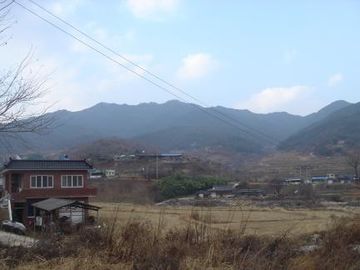합천 무학대사 유허지
| 합천 무학대사 유허지 Historic Site Related to Buddhist Monk Muhak, Hapcheon |
|
 합천 무학대사 유허지, 국가문화유산포털, 문화재청. |
|
| 대표명칭 | 합천 무학대사 유허지 |
|---|---|
| 영문명칭 | Historic Site Related to Buddhist Monk Muhak, Hapcheon |
| 한자 | 陜川 無學大師 遺墟址 |
| 주소 | 경상남도 합천군 대병면 대지리 산 2 일원 |
| 지정(등록) 종목 | 경상남도 기념물 제269호 |
| 지정(등록)일 | 2008년 12월 11일 |
| 분류 | 유적건조물/인물사건/인물기념/생활유적 |
| 시대 | 고려시대 |
| 수량/면적 | 39,918㎡ |
| 웹사이트 | 합천 무학대사 유허지, 국가문화유산포털, 문화재청. |
|
|
|
해설문
국문
이곳 월여산 기슭에는 남북으로 두 곳의 폐사지가 있고, 그 사이에 ‘무학당(無学堂)’이라고 새겨진 바위가 위치하는데, 『삼가현읍지(三嘉縣邑誌)』에 무학대사(無學大師, 1327~1405)가 창건하였다고 기록된 사나사(舍那寺)로 비정되는 곳이기도 하다. 이 때문에 무학대사와 관련된 유적으로 인정되어 ‘무학대사유허지(無學大師 遺墟址)’로 지정되었다.
2007년부터 단계적으로 발굴조사를 실시하여 두 폐사지의 건물배치, 관계를 알 수 있게 되었다. 두 폐사지 중 남쪽이 중심 사찰이고, 북쪽은 중심사찰에 딸린 암자(庵子)이며, 출토된 기와, 자기류 등을 통해 볼 때 중심사찰은 고려 중기인 12세기에 건립되어 18세기에 폐사되었고, 암자는 중심 사찰을 중건(重建)하였던 조선 초기에 세워져 조선 후기에 폐사되었다.
영문
Historic Site Related to Buddhist Monk Muhak, Hapcheon
This site at the foot of Woryeosan Mountain is related to the Buddhist monk Muhak (1327-1405), who lived at the turn of the Goryeo (918-1392) and Joseon (1392-1910) periods.
Born in Samga-myeon Township of Hapcheon County, he was ordained as a monk in 1344. When King Taejo (r. 1392-1398) established the Joseon dynasty in 1392, Muhak was given the post of royal preceptor. As an expert in feng shui and geography, Muhak was also one of the proponents of moving the capital to Hanyang (today’s Seoul).
An excavation conducted here in 2007 revealed two Buddhist temple sites, between which was a rock carving of the name Muhak. It is presumed that the temple to the south was established in the 12th century and abandoned in the 18th century. The temple to the north is presumed to have been a hermitage of the other temple that was established around the 14th century and destroyed in a fire during the late Joseon period.
영문 해설 내용
월여산 기슭에 위치한 이곳은 고려와 조선시대의 승려 무학대사(1327-1405)와 관련한 유적지이다.
무학은 합천 삼가면 출신으로 1344년에 출가하여 승려가 되었다. 1392년 조선이 건국된 후에는 태조(재위 1392-1398)의 왕사로 책봉되었다. 풍수지리에도 능했으며, 태조가 한양을 새 왕도로 정하는 일에 참여하였다.
2007년부터 이루어진 발굴조사 결과, 이곳 월여산 기슭에서는 두 곳의 폐사지가 발견되었고, 두 폐사지 사이에서는 ‘무학’이라는 글씨가 새겨진 바위가 발견되었다. 두 폐사지 중 남쪽이 중심 사찰이고, 12세기에 건립되어 18세기에 폐사된 것으로 추정된다. 북쪽 지역은 14세기 무렵 창건된 부속 암자였던 것으로 추정되며, 화재로 전소되어 조선 후기에 폐사된 것으로 보인다.